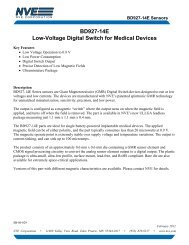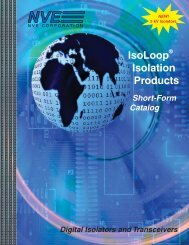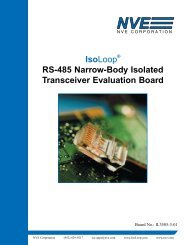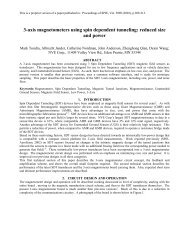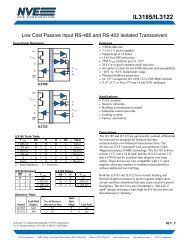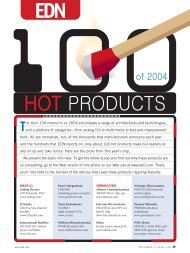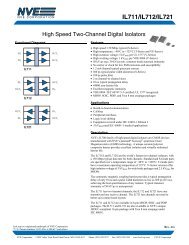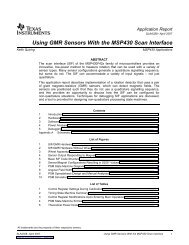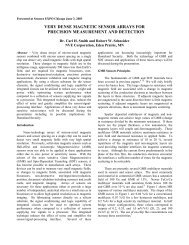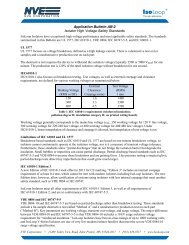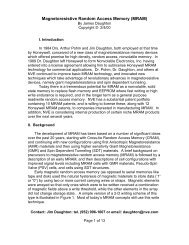67796 NVE -MAY-5E-BRDS - NVE Corporation
67796 NVE -MAY-5E-BRDS - NVE Corporation
67796 NVE -MAY-5E-BRDS - NVE Corporation
You also want an ePaper? Increase the reach of your titles
YUMPU automatically turns print PDFs into web optimized ePapers that Google loves.
THIRTY PAGES OF BIG IDEAS FOR SMALL BUSINESSES IN OUR<br />
10TH ANNUAL SMALL-BUSINESS GUIDE<br />
PIPER FLIES SOLO: AN INTERVIEW WITH CEO ANDREW DUFF • TODAY’S MILLION-DOLLAR HOMES<br />
TwinCities<br />
BUSINESS MONTHLY<br />
<strong>MAY</strong> 2004<br />
Can <strong>NVE</strong>’s<br />
‘Ideal Memory’<br />
Transform the<br />
Computer Chip?<br />
CEO Dan Baker Promises<br />
Faster Computers and Lighter<br />
Cell Phones. Cypress, Agilent<br />
And Motorola Seem to Agree.
Future Memory<br />
<strong>NVE</strong>’s “spintronics” technology could turn the computermemory<br />
world upside down. Is this hot company for real?<br />
By Tony Carideo<br />
E<br />
ven after more than three years as<br />
president and CEO of <strong>NVE</strong> <strong>Corporation</strong>,<br />
Daniel A. Baker still can’t shake the feeling<br />
that he has reached career Nirvana. His<br />
job, he says, is “the opportunity of a lifetime.”<br />
Baker leads a company of 70 employees—most<br />
have technical backgrounds, 10<br />
with Ph.D.s—that is riding a technology<br />
wave that could revolutionize a good<br />
chunk of the electronics industry. With 15<br />
issued patents to support the claim, Eden<br />
Prairie–based <strong>NVE</strong> appears to be at the<br />
cutting edge of a new form of electronic<br />
memory that has broad applications in the<br />
computer world. It’s called magnetic random<br />
access memory, or MRAM. With<br />
MRAM, data are encoded in electrons’<br />
“spin”—a property of an electron based on<br />
the direction of its rotation (“up” or<br />
“down”) about an axis—rather than its<br />
charge. (The industry term for this technology<br />
is “spintronics.”) The upshot for<br />
consumers and businesses: instant-on<br />
computers and smaller, more reliable cell<br />
phones.<br />
“It’s just such a fabulous technology<br />
and opportunity here,” Baker says. “When<br />
I arrived [in 2001], I couldn’t believe that<br />
there was a company like this, with so low<br />
a profile and such great potential.”<br />
Last year, investors also got wind of that<br />
potential. While there aren’t any equitiesindustry<br />
analysts following it, <strong>NVE</strong>’s<br />
stock (Nasdaq: <strong>NVE</strong>C) was one of the<br />
market’s hottest properties in 2003. Going<br />
from $8.60 with hardly any trading at the<br />
beginning of the year to $51.30 by December,<br />
with an average daily volume in<br />
the six figures. The following month, it<br />
climbed into the $60s.<br />
But while <strong>NVE</strong>’s technology offers<br />
great promise, it also faces big hurdles—<br />
and growing investor debate. Established<br />
technologies that are already baked into<br />
product designs, manufacturing processes,<br />
and pricing can be hard to dislodge.<br />
What’s more, <strong>NVE</strong> is a mouse among<br />
such elephants as IBM, Hewlett-Packard,<br />
Fujitsu, Toshiba, and German firm Infineon.<br />
Even though the company has what<br />
Baker describes as “watershed” intellectual<br />
property, several of its competitors have<br />
impressive MRAM IP portfolios of their<br />
own, not to mention more resources to put<br />
them to work. What’s more, one investor<br />
who is “shorting” the stock—meaning he<br />
is betting that the shares will trade lower<br />
from recent levels—argues that <strong>NVE</strong>’s intellectual<br />
property isn’t what it’s cracked<br />
up to be.<br />
Meanwhile, <strong>NVE</strong>’s share price has declined<br />
since January—as of March 31,<br />
<strong>NVE</strong>C stood at $47.68. The decline in<br />
price largely reflects the fact that one of<br />
<strong>NVE</strong>’s license partners, San Jose–based<br />
giant Cypress Semiconductor, has been<br />
slower than expected to get samples of its<br />
spintronics chip into production. Baker’s<br />
task is to make sure that this doesn’t nip<br />
<strong>NVE</strong>’s potentially glorious future in the<br />
bud.<br />
In the Spin<br />
MRAM has been called the ideal memory,<br />
because it has the potential of combining<br />
onto a single chip the compact nature of<br />
dynamic random access memory<br />
(DRAM), the speed of static random access<br />
memory (SRAM), and the nonvolatility<br />
of flash memory. (See sidebar, page 5.)<br />
Does that sound like so much gobbledygook?<br />
Think of it this way: MRAM has<br />
the potential of being to computer technology<br />
what the DVD was to record players.<br />
With DRAM or SRAM, every time you<br />
shut down your computer all of the data<br />
stored on your machine’s circuits goes<br />
bye-bye, unless you’ve saved it on your<br />
hard drive. The “computerese” for that<br />
phenomenon is “volatility.” Each time you<br />
turn on your computer, all the data stored<br />
on your hard drive must be “rewritten”<br />
back onto your DRAM and SRAM before<br />
you can use your programs. That’s why it<br />
takes so long to get your computer up and<br />
running, and why it’s so awful when it<br />
crashes.<br />
An MRAM memory chip is different.<br />
Each of its cells contains a very thin insulating<br />
layer sandwiched between two magnetic<br />
films. Depending on which way their<br />
electrons are spinning, the magnets can<br />
create magnetic fields that point in the<br />
same direction or in opposite directions.<br />
These directions determine whether a cell<br />
stores a “0” or “1” of computer data. A<br />
small amount of electricity switches the<br />
polarity of each cell, depending on the data<br />
being stored. Because MRAM encodes<br />
those zeroes and ones this way, it doesn’t<br />
lose the data when the computer is turned<br />
off. That could mean better data integrity,<br />
smaller equipment footprints, and more re-
CEO Daniel Baker’s charge is to deliver on the promise that<br />
investors believe magnetic random access memory holds—a belief<br />
embodied in his firm’s lofty stock valuation.<br />
liable technology.<br />
Immediate applications<br />
include an entire<br />
new generation of cell<br />
phones that can be<br />
smaller, lighter, and<br />
more sophisticated than<br />
the current technology,<br />
which must employ all three<br />
existing types of memory.<br />
With MRAM, all that could be<br />
made much simpler. The hot new<br />
term in the mobile industry is “a<br />
cell phone on a chip.” It’s a<br />
concept that envisions<br />
Dick Tracy<br />
wristwatch–style<br />
cell phones complete with voice recognition;<br />
cell phones in MP3 players, which allow users to<br />
download and e-mail music over wireless networks;<br />
and smaller PDAs and cell phones coupled with global<br />
positioning satellite technology, that track everything<br />
from your dog’s whereabouts to the precise location of<br />
product shipments.<br />
But the mother lode for MRAM is in computing.<br />
Some developers believe that there will come a day<br />
when they can cram at least as much storage onto an<br />
MRAM chip as they now have on DRAM (the chief<br />
form of computer memory), without DRAM’s disadvantages.<br />
In the past two years, the electronics industry trade<br />
press has embraced MRAM technology. If—and that’s<br />
the operative word here—this type of memory replaces<br />
“We needed to get to<br />
market with our core<br />
technology to show<br />
we knew how to run<br />
a business.”<br />
existing memory architecture in electronic devices,<br />
current estimates of the size of the market for<br />
MRAM technology exceed $40 billion a year.<br />
Memory Strategies International, a Texas-based<br />
memory-industry research firm, estimates that the<br />
cell phone memory segment could make up almost<br />
$9 billion of that total.<br />
Fifteen years after its founding, <strong>NVE</strong> may finally<br />
be ready to cash in on that promise.<br />
PHOTOGRAPH BY MAKI/STRUNC PHOTOGRAPHY<br />
Let’s Get Smaller<br />
<strong>NVE</strong> was started in 1989 as Non-Volatile Electronics<br />
by James A. Daughton, who worked on<br />
early applications of <strong>NVE</strong>’s current technology<br />
as vice president of Honeywell’s Solid<br />
State Development Center. Daughton has<br />
been pursuing the dream of using magnetism<br />
to encode data for more than 20 years.
He conceptualized the idea while at Honeywell,<br />
working with Art Pohm, a now-retired<br />
professor of electrical engineering at<br />
Iowa State University.<br />
“Back then, Honeywell was focusing its<br />
efforts on developing circuitry for the<br />
aerospace and defense industries,”<br />
Daughton recalls. “We were working in 1-<br />
micron increments, which is huge by today’s<br />
standards.” A human hair, as a point<br />
of reference, is about 80 microns in diameter.<br />
Since the early days of Daughton’s research,<br />
however, high technology has<br />
shrunk exponentially. Now nanometers—a<br />
unit of measure equal to 1 billionth of a<br />
meter—or, in some cases, angstroms, are<br />
the relevant units of measurement. One<br />
micron is 1,000 nanometers, or 10,000<br />
angstroms.<br />
Daughton left Honeywell and started his<br />
company with the idea of piggybacking on<br />
Honeywell’s efforts. “My initial intention<br />
was to let Honeywell develop [MRAM],”<br />
he says. “I left with the rights to commercial<br />
development of the technology, while<br />
Honeywell retained the right to military<br />
and avionics [applications]. So I was just<br />
going to ride along.”<br />
Honeywell continued to work on<br />
MRAM technology along with <strong>NVE</strong>, but<br />
it then began to focus on “radiation-hardened”<br />
MRAM to withstand space environments.<br />
It was a direction <strong>NVE</strong> didn’t wish<br />
to take, and Daughton and Pohm (who remains<br />
an advisor to the company) pushed<br />
forward with their own MRAM research.<br />
They won several awards from the Small<br />
Business Administration under its Small<br />
Business Innovation Research program to<br />
fund the development of couplers (which<br />
transmit data) and sensors (for high-precision<br />
data-acquisition), as well as spintronics<br />
technology.<br />
The result: <strong>NVE</strong>’s patents—many of<br />
fundamental importance to the MRAM industry—started<br />
to pile up. Meanwhile,<br />
some industry giants were leaping into the<br />
fray, with companies such as Motorola<br />
and IBM also accumulating dozens of<br />
MRAM-related patents.<br />
Baker entered the story in 2001. Taking<br />
over as CEO from Daughton (now chief<br />
technology officer), Baker has a solid résumé<br />
that includes a Ph.D. in engineering,<br />
a University of Minnesota MBA, and a<br />
stint as president and CEO of Printware,<br />
an Eagan-based maker of computerized<br />
pre-press equipment for the printing industry.<br />
He also was the director of research at<br />
Minntech, a Plymouth-based manufacturer<br />
of medical devices, sterilants, and water<br />
purification products.<br />
“We knew we needed to do two things,”<br />
Baker recalls. “Get to market with some of<br />
our core technology to show we knew<br />
how to run a business, and establish strategic<br />
relationships with companies that had<br />
the financial muscle to accomplish things<br />
that we didn’t have the capital to pursue.”<br />
<strong>NVE</strong>’s technology could put the firm into<br />
a potentially huge market: nanotech.<br />
So far, Baker has delivered. In its most<br />
recent quarter ended December 31, 2003,<br />
<strong>NVE</strong> reported $577,000 in earnings on<br />
$3.1 million in revenues, which were up<br />
33 percent over last year. Earnings were<br />
up 162 percent year over year. The company’s<br />
revenue-producing businesses include<br />
magnetic-based sensors and data<br />
couplers. <strong>NVE</strong>’s tiny sensors, which incorporate<br />
spintronics, are used to position<br />
pneumatic cylinders and robotic arms, to<br />
sense the speed and position of bearings<br />
and electric motor shafts, and in overcurrent<br />
and short circuit detection, to name<br />
just a few applications. <strong>NVE</strong>’s 21,362-<br />
square-foot facility is capable of producing<br />
up to 40 million such devices per year,<br />
going to market through a worldwide network<br />
of sales representatives and distributors.<br />
“We believe that we have some watershed<br />
patents, and that our intellectual<br />
$51.77<br />
<strong>NVE</strong>C<br />
Jan. '04 Apr. '04<br />
$37.20<br />
(3/15)<br />
$66.80<br />
(1/16)<br />
$47.68<br />
property is much broader than the applications<br />
being developed by our partners,”<br />
Baker says.<br />
His optimism isn’t without foundation.<br />
A key factor behind MRAM’s promise is<br />
that it allows engineers to cram much,<br />
much more circuitry into a very, very<br />
small space. That could allow <strong>NVE</strong> to be<br />
part of a potentially huge industry—really<br />
small technology.<br />
The Next Next Big<br />
Thing?<br />
Some in the investment community have<br />
termed nanotechnology “the new Internet.”<br />
(Indeed, one of the hot new books in<br />
the technology space is The Next Big<br />
Thing is Really Small, by Minneapolis<br />
nanotech consultants Deb Newberry and<br />
Jack Uldrich. Uldrich was deputy director<br />
of the Minnesota Office of Strategic and<br />
Long-Range Planning under former Governor<br />
Jesse Ventura.) The “nano” in nanotechnology<br />
is short for nanometer.<br />
What’s more, the technology involved<br />
here often is measured in atoms. A conductive<br />
layer in one of <strong>NVE</strong>’s sensors is<br />
only 12 atoms thick.<br />
<strong>NVE</strong> is “on everybody’s nanotech list,”<br />
says Clint Morrison, an analyst at Piper<br />
Jaffray in Minneapolis who has covered<br />
the local technology industry for more<br />
than 20 years. “It’s really tough to invest<br />
in this area. You’re often dealing with<br />
companies like IBM and Motorola. And<br />
here you have a pure play in that space.”<br />
As for MRAM, “the technology is real,”<br />
asserts Morrison (who owns no <strong>NVE</strong><br />
stock). Indeed, he says that MRAM “could<br />
be the holy grail of the next generation of<br />
memory. The question now is, can it be<br />
commercialized?”<br />
There’s another question: Can <strong>NVE</strong> be<br />
the one to commercialize it?<br />
A year after its founding, the company<br />
began notching its belt with a who’s who<br />
of strategic partners, licensees, media attention,<br />
and more government backing.<br />
These include contracts from the U.S.<br />
Army, the U.S. Air Force Research Laboratory,<br />
and the Defense Sciences Office of<br />
the Defense Advanced Research Projects<br />
Agency, as well as grants from the National<br />
Science Foundation. Meanwhile, spintronics<br />
technology has been featured in an<br />
array of esoteric engineering and sciencerelated<br />
trade publications, and was the<br />
cover story in the June 2002 issue of Scientific<br />
American.<br />
While this sort of attention is nice, it’s<br />
the company’s license agreements with the<br />
likes of Motorola, Cypress, Agilent Technologies,<br />
and Union Semiconductor Technology<br />
that could take this story to the<br />
bank.<br />
In late 2000, <strong>NVE</strong> cleared away any lin-
Memory is Made of These<br />
• Dynamic random access memory<br />
(DRAM). The predominant form of<br />
semiconductor memory used in the<br />
electronics industry today. It typically stores<br />
bits of information as an amount of electrical<br />
charge in a storage cell.<br />
• Static RAM (SRAM). “Static” means that<br />
the memory retains its contents as long as<br />
electricity is applied—unlike DRAM, which<br />
needs to be “rewritten” or “refreshed” many<br />
times per second. Faster and more<br />
expensive than DRAM, SRAM is used by the<br />
most speed-critical parts of a computer, such<br />
as cache memory. But while SRAM is faster,<br />
it is less dense than DRAM, and thus takes<br />
up more space.<br />
• Flash. A non-RAM form of memory used for<br />
easy and fast information storage. Applications<br />
include digital cameras, personal digital<br />
assistants, and PC cards. Flash memory is<br />
slow to “write” data, and wears out over time.<br />
• Magnetic RAM (MRAM). A still-nascent<br />
memory technology that encodes information<br />
via the spin of magnetized electrons. Early<br />
applications are expected to include cell<br />
phones. MRAM has the potential to be as<br />
fast as an SRAM chip and as high-density as<br />
DRAM, according to proponents. But its main<br />
advantage over SRAM and DRAM is<br />
nonvolatility—it retains information even<br />
when the electronic device is off. Its<br />
advantages over flash are faster write times<br />
and greater durability.<br />
—Gene Rebeck<br />
that payday comes.<br />
Great Expectations<br />
For all the minuteness of <strong>NVE</strong>’s products<br />
(and its relatively small revenues), investors<br />
have been willing to pay big dollars<br />
for its shares. Even though <strong>NVE</strong>’s<br />
stock price has slipped from a 52-week<br />
high of $69.69 down to the mid-$40s, its<br />
shares are trading at more than 18 times<br />
sales—and 126 times projected full-year<br />
earnings for the fiscal year that ended in<br />
March.<br />
It was inevitable that such valuations<br />
would attract short-sellers—investors who<br />
borrow stock from other investors in<br />
hopes that the stock will drop in price, allowing<br />
them to buy it in the open market,<br />
return the borrowed stock at its original<br />
price, and pocket the difference. In mid-<br />
March, Manuel Asensio, a New York–<br />
based analyst, launched an attack on the<br />
company’s valuation, arguing that a combination<br />
of high insider sales and what he<br />
contends is low-value intellectual property<br />
suggests that the stock is wildly overvalued.<br />
Indeed, insiders have been selling—<br />
with Baker and Daughton selling or announcing<br />
the sale of stock worth more<br />
than $14 million. Baker defends these<br />
moves, which took place primarily in December<br />
2003 and January of this year, noting<br />
that he still has more than 70,000 in<br />
vested options that he could sell, but<br />
hasn’t.<br />
“I have retained significant [equity] interest<br />
and exposure to the company’s stock<br />
price,” Baker says. As for <strong>NVE</strong>’s technology,<br />
“We believe we have valuable intellectual<br />
property,” he says. “We have constantly<br />
improved and added to our intellectual<br />
property portfolio. The standard isn’t based<br />
just on the intellectual property Motorola<br />
licensed in 1995. We’ve continued to add<br />
to that portfolio. We believe we have one<br />
of the best IP portfolios in the industry.”<br />
One of the big factors driving <strong>NVE</strong>’s<br />
skyrocketing stock price was the deal it<br />
signed in April 2002 with Cypress. In exchange<br />
for <strong>NVE</strong>’s intellectual property and<br />
17 percent ownership of the company, Cypress<br />
pumped $6.2 million in capital into<br />
<strong>NVE</strong>. That investment bootstrapped<br />
<strong>NVE</strong>’s stock from the over-the-counter<br />
bulletin boards to the much more widely<br />
traded Nasdaq, greatly increasing the company’s<br />
liquidity and broadening the regulatory<br />
eligibility for investors. But the really<br />
big news was Cypress’ plans to produce an<br />
MRAM computer memory chip by March<br />
2004 and then manufacture chips at the Silicon<br />
Valley firm’s Bloomington facility.<br />
But in January, word got out that Cypress<br />
was encountering delays in getting<br />
chip production on line. Cypress had said<br />
only that it hoped to have samples by the<br />
end of March. Meanwhile, bulls and bears<br />
have whiplashed <strong>NVE</strong>’s stock, pushing it<br />
down to the high $30s one day, only to<br />
have it bounce back, often as much as $4<br />
to $5 per share, the next. (See stock chart.)<br />
In a story that seems to evolve by the<br />
minute, Cypress indicated on March 19<br />
that it had produced the chip—not, perhaps,<br />
in a full production form, but at least<br />
<strong>NVE</strong> suddenly became a hot stock in<br />
2003. That has made the firm a target<br />
for short-sellers —and naysayers.<br />
gering licensing complications with Honeywell<br />
in exchange for a payment to <strong>NVE</strong><br />
of more than $1 million. In the fall of<br />
2001, <strong>NVE</strong> granted nonexclusive rights to<br />
some of its coupler technology to Agilent<br />
Technologies for upwards of $1 million in<br />
fees and advance payments in the first<br />
year of the agreement, along with future<br />
payments based on sales of the Agilent<br />
products covered by the agreement.<br />
At this point, <strong>NVE</strong>’s big-money bet is<br />
with Illinois-based Motorola, which owns<br />
about 5 percent of <strong>NVE</strong>. This relationship<br />
dates to 1995, when Motorola licensed the<br />
company’s MRAM technology for the development<br />
of new cell phone technology.<br />
Last October, Motorola announced that it<br />
had produced its first samples of MRAM<br />
chips—well ahead of a joint venture between<br />
IBM and Infineon. Motorola has targeted<br />
pilot production for late 2004. If Motorola<br />
uses <strong>NVE</strong>’s technology, the Minnesota<br />
firm would earn a 1 percent royalty<br />
on the sales of the chip.<br />
But the big payday for the company will<br />
come with licenses from other manufacturers<br />
that step through the door after the<br />
technology has been proven. That is, if<br />
on a proof-of-concept basis. No specific<br />
date was given for when actual production<br />
would begin. Nonetheless, the news<br />
caused the stock price to jump again.<br />
Cypress aside, Baker emphasizes that<br />
<strong>NVE</strong>’s Motorola relationship is still another<br />
powerful component of the <strong>NVE</strong> story,<br />
and that the Cypress project is focused on<br />
only one type of computer memory. He<br />
suggests, in other words, that there will be<br />
other opportunities for his firm’s MRAM<br />
technology.<br />
“A lot of the valuation [of our stock] is<br />
based on the quality of our intellectual<br />
property and the tremendous potential of<br />
MRAM to revolutionize an industry,”<br />
Baker says. “We believe we have the intellectual<br />
property and technology that<br />
makes us the current leader in the practical<br />
use of MRAM. Those kinds of things<br />
come along very rarely.” ■<br />
Tony Carideo (tony@carideogroup.com)<br />
is president of The Carideo Group, a Minneapolis-based<br />
integrated corporate communications<br />
company. His firm does not<br />
represent <strong>NVE</strong>.<br />
REPRINTED WITH PERMISSION FROM TWIN CITIES BUSINESS MONTHLY • COPYRIGHT BY MSP COMMUNICATIONS



